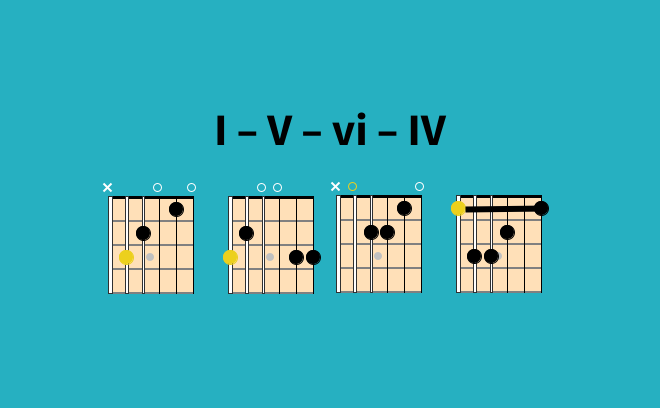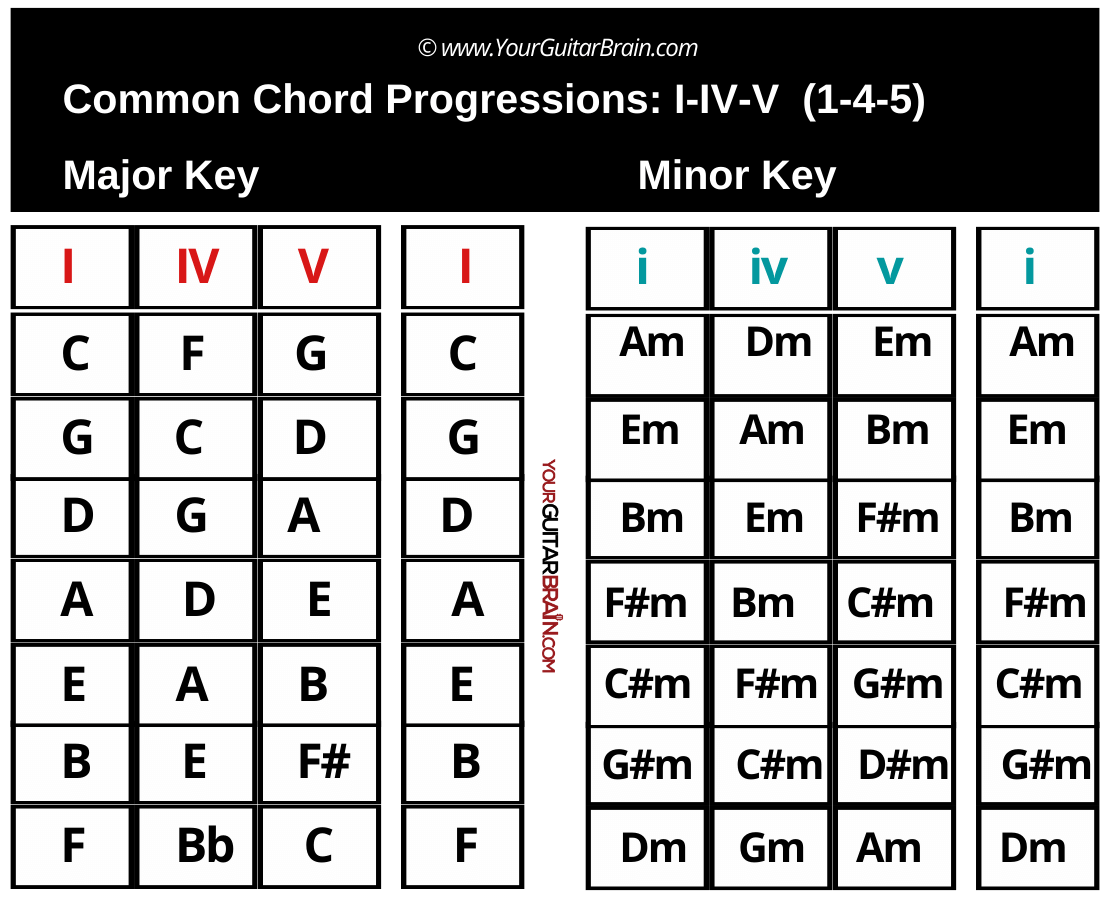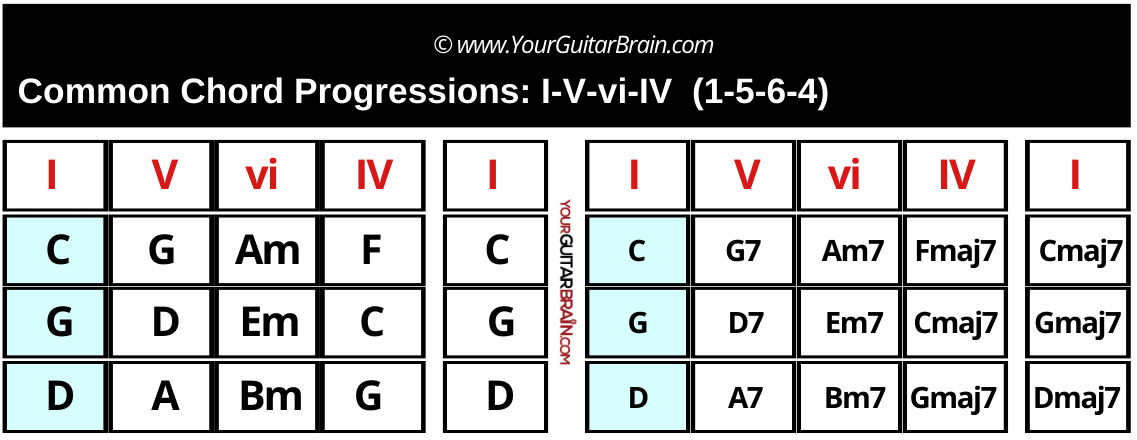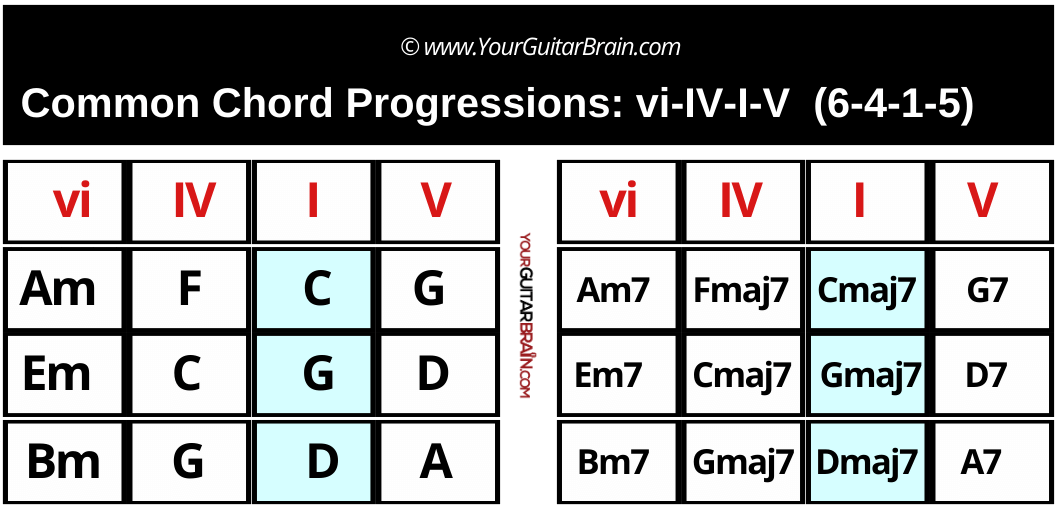Master the most popular chord progressions in pop, rock, and blues with this essential guide for guitar players of all levels.
- Learn to play 100’s of your favourite songs with these wickedly good chord progressions.
- We reveal the top 5 chord progressions all guitar players need to know.
- Wonder what accessories all guitar players should have? Check out our guide to the best guitar accessories here.
In this post, you’ll learn the most popular chord progressions in pop, rock, and other genres. This knowledge will help you learn songs faster, write your own songs easier, and understand the music you love.
Before we dive into the list of common chord progressions, we’ll answer a few beginner guitar player questions.
What is a Chord Progression?
A chord progression is simply a sequence of chords played in a certain order in a piece of music.
Furthermore, some chords help move a song along, some add suspense, whilst one acts as the tonal centre ‘home chord’.
There are many popular chord progressions that have been used time and time again to make 1000’s of songs.
These common chord sequences sound good because they use what we call functional harmony.
What is Functional Harmony?
In a nutshell, functional harmony is the idea that chords (harmony) have a specific relationship to the tonal centre of a piece of music (the first chord or note), as well as to each other.
Functional harmony also tells us that each chord helps to move a piece of music along, much like words do in a storybook.
Every chord provides either stability, anticipation or tension on their way back home to resolve to the tonic chord.
What is a Tonic?
The tonic is the first note (aka degree) in a major or minor scale which acts as the tonal centre of a piece of music.
The tonic degree further builds the tonic triad (first chord) in a song which is regarded as the ‘home chord’ because it gives a sense of resolution to the music.
The tonic chord (harmony) or note (melody) is at rest and content with life. When you reach the tonic in a passage of music, there is no tension, no suspense…it feels like you’re back home.
The tonic of a key is the most important scale degree, as it is where our ear longs to return back to.
Key Takeaway
The tonic is the same note as the name of the key signature. Put another way, if a song is ‘in D Major’, then the D note and the D Major chord are the tonic.
Top 5 Chord Progressions
Now I’m going to show you some useful reference cheat sheets for the top five common chord progressions found across all musical styles.
There are jazz chord progressions, pop chord progressions, blues chord progressions and major chord progressions.
Before we dive into the progressions, here’s a little reminder of the chord formulas for both major and natural minor keys:
Major: I= major, ii= min, iii= min, IV= major, V =major, vi=min, vii˚ =dim
Minor: i =minor, ii˚ =dim, III =major, iv =minor, v =minor, VI =major, VII =major
#1. Chord Progression I - IV - V | (1-4-5)
I just had to start you off with the 1-4-5 chord progression. There’s no two ways about it; this iconic chord progression is the foundation of many styles of music, particularly classic rock ‘n’ roll, punk and rock.
Synonymous with 12-bar blues, the 1-4-5 progression sounds positive and upbeat, thanks to the three primary major chords.
The perfect cadence movement (see below) between the V-I chords adds to the popularity of the flavour and mood this chord progression creates.
Below is a table showing you the chords found in the most used major keys on guitar, along with their relative minor key signatures that follow the I-IV-V progression.
Q. What is a perfect cadence in music?
A perfect cadence is a musical ending that sounds very final. It is made up of two chords, the dominant (5th) chord and the tonic (1st) chord in a key signature.
For example, in the key of C major, the dominant chord is G major, and the tonic chord is C major. A perfect cadence would be formed by playing G major, followed by C major.
The perfect cadence is often used to end a musical phrase or section. It can also be used to create a sense of finality or closure.
Pro Tip
If you're a beginner guitar player, take the time to work on getting your chord changes smooth and clean. This will help make your chord progressions sing. Be patient and stay focused. Perfect chords only happen with consistent daily practice.
#2. Chord Progression I-V-vi-IV | (1-5-6-4)
The 1-5-6-4 progression is the staple of popular music. You don’t have to look far to find hundreds of hit songs in mainstream music that follow this four-chord formula.
The contrast between the chords is what makes the I-V-vi-IV progression work so well across many music styles.
The reference table above shows you the chords in the enormously popular 1-5-6-4 chord progression for the first three key signatures: C major, G major, and D major.
The tonic (I) is highlighted in blue. The basic triads are shown along with the harmonically richer-sounding seventh extensions.
Pro Tip
Start and end your chord progression on the tonic (I) chord. This is the most common way to end a chord progression, and it will give your song a satisfying sense of closure.
#3. Chord Progression vi–IV–I–V | (6-4-1-5)
The 6-4-1-5 progression is a slight tweak on the previous classic I-V-vi-IV sequence and is a favourite of songwriters thanks to its catchy, familiar sound.
The way the chords move in this progression is very smooth and natural. Each chord seems to flow into the next one seamlessly. When you start on the relative minor chord, you create an emotional vibe.
The chord progression chart above shows the triad chords along with the alternative seventh chords in the first three major keys.
Add this progression to your weekly guitar practice schedule, and you’ll be improving your rhythm playing at breakneck speeds.
Pro Tip
Swap out the seventh chords for some more sophisticated chord extensions. Try a C major 9th, Gmaj9th or an Em11th for starters.
Don’t know enough interesting chords? Check out our Essential Jazz Guitar Chords Chart Poster, featuring 65 of the most used common jazzy-sounding chord shapes | Visit Etsy Shop
#4. Chord Progression ii–V–I | (2-5-1)
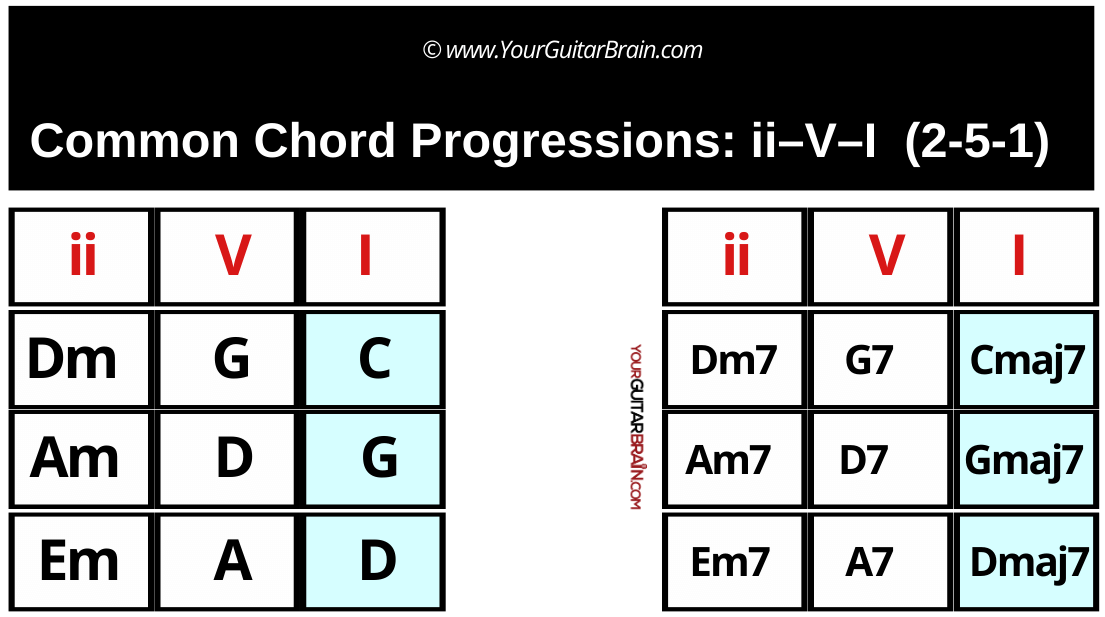
Easily the most used chord progression when it comes to the jazz world, next up is the 2-5-1 chord progression.
The bread and butter of jazz music, the 2-5-1 progression dominates the genre largely because jazz harmony is based around the cycle of fourths (see below).
The II degree in the progression is a fourth away from the V, which is also a fourth away from the tonic (I).
The chord progression chart above shows examples in the first three major key signatures.
Q. What is the circle of fourths?
The cycle of fourths is a musical pattern that goes from one chord to the next by moving four semitones up or down.
For example, in the key of C major, the cycle of fourths would go from C major to F major to Bb major to Eb major and so on.
Jazz harmony is based around the cycle of fourths because it creates a sense of forward motion and momentum.
When chords are arranged in a circle of fourths, they tend to lead naturally to each other. This makes it easy for jazz musicians to improvise and create solos that are both interesting and melodic.
The 2-5-1 progression is a perfect example of how the cycle of fourths can be used to create a sense of forward motion.
The ii chord is the dominant chord of the V chord, and the V chord is the dominant chord of the I chord.
This means that the 2-5-1 progression creates a strong sense of tension and resolution, which is essential for creating a good groove.
#5. Chord Progression I-vi-IV-V | (1-6-4-5)
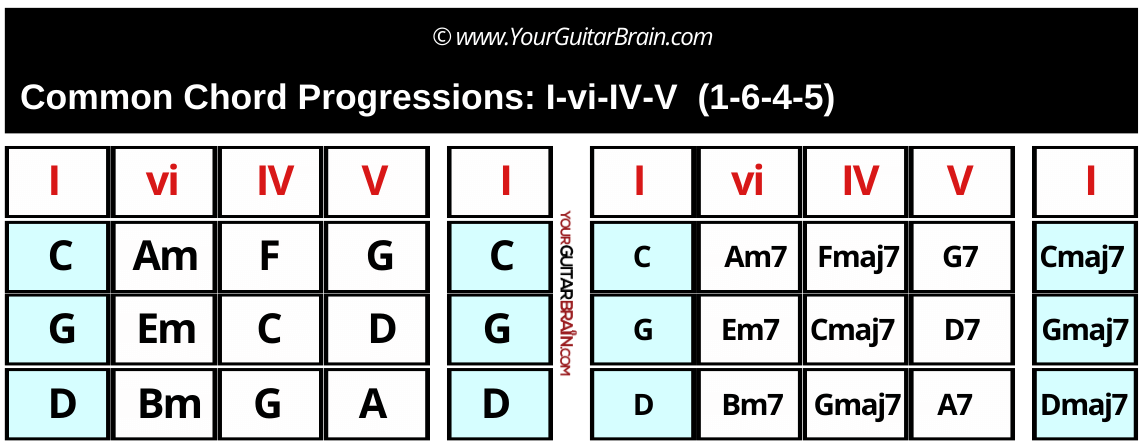
You’re probably starting to see that most common chord progressions in Western music are pretty similar.
This is helpful for beginner writers because it means that there are a few basic patterns that you can learn and use to create your own songs.
Once you understand these patterns, you can start to experiment with different variations and combinations to create your own unique sound.
In this next 1-6-4-5 progression, we once again see that pleasing perfect cadence at the end when the 5th degree resolves to the tonic (I).
The I-vi-IV-V chord progression is sometimes called “The 50’s Progression” because, yep, you guessed it, it was popular in songs from the 1950s-1960’s period.
The table above shows you the chords in the tried and tested 1-6-4-5 progression in three keys.
Pro Tip
Change up the chord voicings from the regular shapes you’d default to playing when you play this. Also, record yourself playing to keep an audio diary of your improvement.
Practice Tips:
1. Divide and conquer: To effectively use your practice time, make sure you don’t bite off more than you can chew. As you can see, some key signatures look more complicated than others, with loads of sharp/flats.
Start with the first two ‘easier’ keys of C major and G major. Both keys only have one sharp/flat note between them (F#).
2. Feel the rhythm: Try out different rhythms and strumming patterns and record yourself practicing the chord progressions.
3. Different tempos: Record down three different tempo backing tracks for each of the chord progressions. Try laid back (60bpm approx), moderate (90bpm approx) and faster (130bpm approx). Stick to slow speeds if you’re a total beginner; otherwise, you’ll be all over the place.
4. Key change: Apply the chord progression formulas to different key signatures. Write the chords out.

